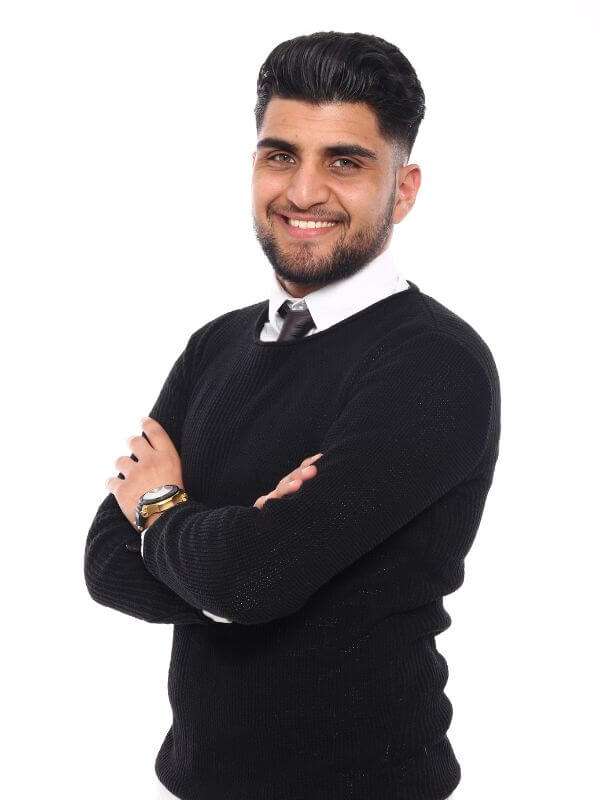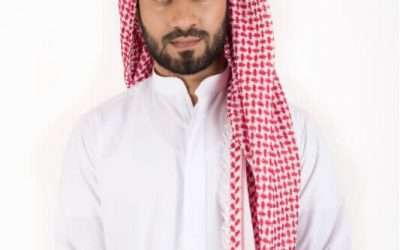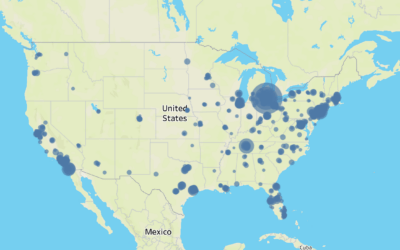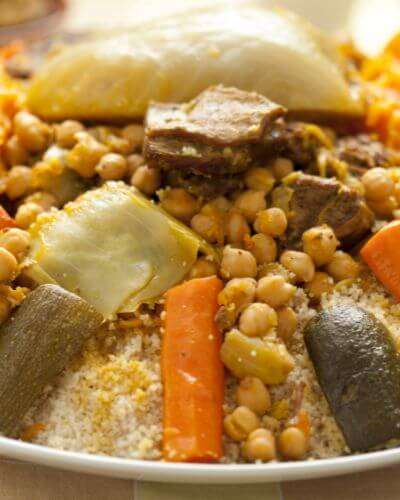Moroccan Arabs in North America

The majority of the Moroccans in the North American diaspora arrived after 1990. Those who settled in the US or Canada before 1990 typically came for educational opportunities. New arrivals tend to settle in places where a large population of Moroccans already live, with metro New York City and greater Montreal having the largest populations in North America. Moroccans typically enter the United States with higher education and job skills than other Arab groups. Common vocations include professions such as banking, engineering, computer science, medicine, architecture, journalism, research, and teaching.
In Moroccan culture, families are often large, and extended families often live together. The family’s father is the leader, and the mother typically takes on domestic responsibilities. In the past, women stayed at home, but it is becoming more common for them to work outside the home.
The Moroccan dialect of Arabic, known as Darija, is the most widely used language in homes. Berber is the other official language of Morocco but is generally only spoken by Berbers. Schools, government, and mosques use Standard Arabic. Minority languages include Hassaniya Arabic, French, and Spanish.
There are well over 312,000 Moroccan Arabs in North America today. in addition to New York City and Montreal, Toronto, Los Angeles, and Washington, DC also have sizable communities of Moroccan Arabs.
Religious Life
Religion strongly influences the Moroccan culture. Most Moroccan Arabs are Muslim and follow the follow the Maliki rite of Sunni Islam. There are a small minority of Shia followers and small numbers of followers of the Christian or Jewish faiths. As an example of the societal influence, Moroccans refer to their king as ‘Amir El Mouminin,’ or leader of the faithful, an Islamic term. Moroccan Muslim women enjoy a higher level of freedom compared to much of the Islamic world.
The Moroccan government has tried to help Moroccans living in the diaspora maintain their cultural and religious identity through associations that reach out to communities in other countries. Therefore, much of the Moroccan Arab population in North America continues to identify closely with Islam, and there is a great need for work among these unreached people.
These are the Moroccan Arab communities in North America most in need of gospel witness
| People Group | Metropolitan Area | Population Size | Concentrated Area | Priority Score |
|---|---|---|---|---|
| Afghan | Houston | 9,850 | Gulfton | 48 |
| Afghan | Los Angeles | 16,719 | Irvine | 57 |
| Afghan | Montreal | 10,805 | Saint-Martin (Laval) | 59 |
| Afghan | New York | 9,871 | Flushing (Queens) | 49 |
| Afghan | Sacramento | 21,673 | Elk Grove | 69 |
| Afghan | San Diego | 7,189 | El Cajon | 58 |
| Afghan | San Francisco | 32,142 | Fremont | 69 |
| Afghan | Seattle | 6,994 | Kent | 54 |
| Afghan | Toronto | 43,075 | Scarborough | 57 |
| Afghan | Vancouver | 7,980 | New Westminster | 51 |
| Afghan | Washington D.C. | 33,236 | Springfield | 73 |
| Afghan Hindu/Sikh | New York | 6,000 | Hicksville (Long Island) | 86 |
| Albanian Muslim | Boston | 15,903 | Revere | 53 |
| Albanian Muslim | Chicago | 11,230 | Berkeley/Elmhurst | 49 |
| Albanian Muslim | Detroit | 19,949 | Sterling Heights | 55 |
| Albanian Muslim | New York | 48,123 | Pelham Parkway (Bronx) | 65 |
| Albanian Muslim | Philadelphia | 6,857 | Northeast | 35 |
| Algerian Arab | Montreal | 59,585 | Little Maghreb | 71 |
| Bambara | New York | 5,000 | Harlem | 69 |
| Bangladeshi | Atlanta | 5,839 | Doraville | 46 |
| Bangladeshi | Dallas Fort Worth | 6,355 | Irving | 47 |
| Bangladeshi | Detroit | 11,087 | Hamtramck | 44 |
| Bangladeshi | Los Angeles | 7,362 | Little Bangladesh | 46 |
| Bangladeshi | Montreal | 10,675 | Parc Extension | 48 |
| Bangladeshi | New York | 84,099 | Jamaica (Queens) | 41 |
| Bangladeshi | Philadelphia | 7,295 | Hatfield | 47 |
| Bangladeshi | Toronto | 36,670 | Danforth Village | 47 |
| Bangladeshi | Washington D.C. | 11,798 | York Town (Arlington) | 48 |
| Belzer Jewish | New York | 12,518 | 86 | |
| Bobover Jewish | New York | 23,509 | 90 | |
| Bosniak | Atlanta | 12,000 | Lawrenceville | 61 |
| Bosniak | Boston | 8,000 | Revere | 59 |
| Bosniak | Bowling Green | 5,000 | Morgantown Road | 60 |
| Bosniak | Chicago | 60,000 | Northside | 81 |
| Bosniak | Des Moines | 10,000 | Merle Hay | 63 |
| Bosniak | Detroit | 10,000 | Hamtramck | 64 |
| Bosniak | Grand Rapids | 10,000 | Kentwood | 63 |
| Bosniak | Jacksonville | 11,000 | Hogan | 65 |
| Bosniak | New York | 12,000 | Astoria (Queens) | 63 |
| Bosniak | Phoenix | 10,000 | Glendale | 64 |
| Bosniak | Seattle | 6,000 | Shoreline | 60 |
| Bosniak | St. Louis | 70,000 | Mehlville | 79 |
| Bosniak | Toronto | 7,120 | Etobicoke | 61 |
| Bosniak | Utica | 5,000 | Bleecker St. | 60 |
| Breslov Jewish | New York | 5,000 | 86 | |
| Bukharan Jewish | New York | 60,000 | 74 | |
| Chabad Lubavitch Jewish | New York | 27,103 | 91 | |
| Egyptian Arab | Boston | 5,359 | Dudley Square | 23 |
| Egyptian Arab | Chicago | 5,784 | Hickory Hills | 23 |
| Egyptian Arab | Dallas Fort Worth | 5,136 | Richardson | 33 |
| Egyptian Arab | Houston | 5,992 | Katy | 32 |
| Egyptian Arab | Los Angeles | 23,765 | Anaheim | 40 |
| Egyptian Arab | Montreal | 9,167 | Saint-Laurent | 27 |
| Egyptian Arab | New York | 56,257 | Astoria (Queens) | 46 |
| Egyptian Arab | Philadelphia | 5,249 | Center City | 33 |
| Egyptian Arab | San Francisco | 7,274 | Oakland | 27 |
| Egyptian Arab | Toronto | 11,637 | Mississauga | 42 |
| Egyptian Arab | Washington D.C. | 12,313 | Lanier Heights | 25 |
| Fouta Tooro | Cincinnati | 5,000 | Lockland | 75 |
| Fouta Tooro | New York | 7,600 | Bed-Stuy (Brooklyn) | 78 |
| Fulbe Futa | New York | 5,000 | Morrisania (Bronx | 77 |
| Gerer Jewish | New York | 8,791 | 84 | |
| Gorsky-Kavkazi Jewish | New York | 10,000 | 89 | |
| Gujarati | Atlanta | 26,019 | Big Creek | 52 |
| Gujarati | Boston | 16,736 | Town of Acton | 59 |
| Gujarati | Calgary | 6,500 | Horizon | 52 |
| Gujarati | Charlotte | 7,465 | Mallard Creek | 46 |
| Gujarati | Chicago | 53,444 | Georgetown | 44 |
| Gujarati | Dallas Fort Worth | 19,822 | Plano | 46 |
| Gujarati | Detroit | 9,457 | Farmington | 54 |
| Gujarati | Edmonton | 6,730 | Strathcona Industrial Park | 52 |
| Gujarati | Houston | 25,456 | Sugar Land | 61 |
| Gujarati | Los Angeles | 25,666 | Woodbury | 44 |
| Gujarati | Miami | 5,762 | Plantation | 53 |
| Gujarati | Montreal | 6,970 | Dollard-Des Ormeaux | 55 |
| Gujarati | Orlando | 7,603 | Willamsburg | 52 |
| Gujarati | New York | 125,454 | Edison (NJ) | 70 |
| Gujarati | Philadelphia | 36,953 | Hatfield | 43 |
| Gujarati | Raleigh | 8,207 | Shiloh | 45 |
| Gujarati | San Francisco | 29,547 | Fremont | 52 |
| Gujarati | Tampa | 6,001 | Brandon | 51 |
| Gujarati | Toronto | 70,490 | Brampton | 61 |
| Gujarati | Vancouver | 7,075 | South Vancouver | 58 |
| Gujarati | Washington D.C. | 21,491 | Calverton | 60 |
| Indian Hindi | Atlanta | 40,586 | Big Creek | 36 |
| Indian Hindi | Austin | 14,774 | Walsh Creek | 47 |
| Indian Hindi | Boston | 36,888 | Town of Acton | 55 |
| Indian Hindi | Calgary | 20,232 | Castleridge | 37 |
| Indian Hindi | Charlotte | 11,890 | Mecklenburg | 41 |
| Indian Hindi | Chicago | 50,852 | West Ridge "Little India" | 41 |
| Indian Hindi | Cincinnati | 7,450 | Clifton Heights | 47 |
| Indian Hindi | Cleveland | 5,397 | Glenwillow | 48 |
| Indian Hindi | Columbus, OH | 11,924 | Polaris | 36 |
| Indian Hindi | Dallas Fort Worth | 54,777 | Frisco | 32 |
| Indian Hindi | Denver | 7,422 | Sedalia | 52 |
| Indian Hindi | Detroit | 17,706 | Troy | 54 |
| Indian Hindi | Edmonton | 18,855 | SE Edmonton | 49 |
| Indian Hindi | Hartford | 9,534 | Rocky Hill | 49 |
| Indian Hindi | Houston | 37,843 | Sugar Land | 36 |
| Indian Hindi | Indianapolis | 6,429 | Wayne Township | 51 |
| Indian Hindi | Kansas City | 5,455 | Overland Park | 51 |
| Indian Hindi | Kitchener | 8,593 | West Mount | 36 |
| Indian Hindi | Los Angeles | 59,692 | Artesia | 35 |
| Indian Hindi | Miami | 12,747 | Plantation | 55 |
| Indian Hindi | Twin Cities | 7,900 | Edina | 50 |
| Indian Hindi | Montreal | 15,417 | Parc Extension | 56 |
| Indian Hindi | New York | 179,353 | Jersey City, Edison | 46 |
| Indian Hindi | Orlando | 12,718 | Williamsburg | 50 |
| Indian Hindi | Ottawa | 8,658 | Napean/Westboro | 55 |
| Indian Hindi | Philadelphia | 25,586 | King of Prussia | 56 |
| Indian Hindi | Phoenix | 16,149 | Chandler-Kirby Estates | 55 |
| Indian Hindi | Pittsburgh | 6,861 | Marshall Township | 48 |
| Indian Hindi | Portland | 7,433 | Bethany | 43 |
| Indian Hindi | Raleigh | 11,417 | Morrisville | 45 |
| Indian Hindi | Sacramento | 14,943 | Valley Hi/North Laguna | 44 |
| Indian Hindi | St.Louis | 6,101 | Ballwin | 44 |
| Indian Hindi | San Diego | 11,739 | Miramar | 49 |
| Indian Hindi | San Francisco | 153,853 | Fremont | 43 |
| Indian Hindi | Seattle | 31,712 | Bellevue | 31 |
| Indian Hindi | Tampa | 7,828 | Brandon | 52 |
| Indian Hindi | Toronto | 150,062 | Etobicoke | 45 |
| Indian Hindi | Vancouver | 49,718 | South Vancouver | 37 |
| Indian Hindi | Washington D.C. | 66,808 | Ellicott city | 47 |
| Indian Hindi | Winnipeg | 10,649 | Colony (Little India) | 53 |
| Indonesian | Los Angeles | 7,500 | San Bernardino | 29 |
| Iraqi Arab | Atlanta | 5,000 | Clarkston | 38 |
| Iraqi Arab | Austin | 7,963 | Pflugerville | 43 |
| Iraqi Arab | Chicago | 11,476 | Northbrook | 53 |
| Iraqi Arab | Dallas Fort Worth | 11,319 | Richardson | 41 |
| Iraqi Arab | Detroit | 68,626 | East Dearborn | 57 |
| Iraqi Arab | Houston | 11,914 | Mid-West | 41 |
| Iraqi Arab | Los Angeles | 5,771 | Glendale | 39 |
| Iraqi Arab | New York | 8,443 | Astoria (Queens) | 47 |
| Iraqi Arab | Phoenix | 19,457 | Northern Village | 43 |
| Iraqi Arab | San Antonio | 5,180 | Alamo Heights | 38 |
| Iraqi Arab | San Diego | 25,923 | El Cajon | 57 |
| Iraqi Arab | San Francisco | 7,913 | Modesto | 39 |
| Iraqi Arab | Toronto | 10,732 | Vaughan | 45 |
| Iraqi Arab | Washington D.C. | 9,685 | Lanier Heights | 42 |
| Israeli Sabra Jewish | Los Angeles | 18,885 | Pico Robertson & Fairfax | 60 |
| Israeli Sabra Jewish | Miami | 12,299 | Plantation | 54 |
| Israeli Sabra Jewish | New York | 36,720 | 66 | |
| Israeli Sabra Jewish | San Francisco | 9,384 | Sunnyvale | 51 |
| Israeli Sabra Jewish | Toronto | 9,750 | North York | 49 |
| Jordanian Arab | Chicago | 9,519 | Bridgeview | 40 |
| Jordanian Arab | Detroit | 7,132 | East Dearborn | 37 |
| Jordanian Arab | Los Angeles | 7,184 | Anaheim | 33 |
| Jordanian Arab | New York | 8,192 | Astoria (Queens) | 25 |
| Jula | New York | 5,000 | Harlem | 69 |
| Kabyle Berber | Montreal | 29,174 | Longue-Pointe | 49 |
| Kazakh | New York | 5,969 | Brighton Beach (Brooklyn) | 50 |
| Kurd | Dallas Fort Worth | 6,500 | South Arlington | 52 |
| Kurd | Nashville | 15,000 | Elysian Fields | 53 |
| Kurd | Toronto | 6,630 | York | 50 |
| Kyrgyz | Chicago | 15,000 | Des Plaines | 71 |
| Kyrgyz | New York | 5,000 | Brighton Beach (Brooklyn) | 68 |
| Lebanese Arab | Boston | 22,539 | Somerville | 35 |
| Lebanese Arab | Chicago | 5,681 | Bridgeview | 47 |
| Lebanese Arab | Cleveland | 6,012 | West Cleveland | 28 |
| Lebanese Arab | Dallas Fort Worth | 5,671 | Richardson | 27 |
| Lebanese Arab | Detroit | 33,099 | East Dearborn | 42 |
| Lebanese Arab | Houston | 6,622 | Mid West | 27 |
| Lebanese Arab | Los Angeles | 18,893 | Monterey Park | 35 |
| Lebanese Arab | Miami | 7,622 | Upper Eastside | 47 |
| Lebanese Arab | Montreal | 20,607 | Saint-Laurent | 39 |
| Lebanese Arab | New York | 20,901 | Paterson | 34 |
| Lebanese Arab | Ottawa | 8,855 | South Ottawa | 31 |
| Lebanese Arab | Toronto | 7,595 | Mississauga | 32 |
| Lebanese Arab | Washington D.C. | 9,239 | Woodley Park | 33 |
| Mandinka | New York | 5,000 | Highbridge (Bronx) | 81 |
| Maninka | New York | 5,000 | Concourse (Bronx) | 76 |
| Persian Jewish (Mashadi) | New York | 5,000 | 88 | |
| Moroccan Arab | Boston | 12,602 | Malden | 46 |
| Moroccan Arab | Chicago | 5,000 | Bridgeview | 44 |
| Moroccan Arab | Detroit | 6,660 | Hamtramck | 37 |
| Moroccan Arab | Los Angeles | 7,272 | Central LA-Beverly Wood | 44 |
| Moroccan Arab | Miami | 9,651 | Upper Eastside | 47 |
| Moroccan Arab | Montreal | 60,775 | Little Maghreb | 72 |
| Moroccan Arab | New York | 41,356 | Astoria (Queens) | 57 |
| Moroccan Arab | Philadelphia | 6,114 | Center City | 41 |
| Moroccan Arab | Washington D.C. | 28,279 | Brockwood | 50 |
| Moroccan Jewish | Toronto | 5,000 | North York | 83 |
| Moroccan Jewish | Montreal | 10,000 | Hampstead | 64 |
| Indo-Pak Muslims | Atlanta | 26,175 | Roswell | 40 |
| Indo-Pak Muslims | Austin | 9,336 | Northwest Austin | 39 |
| Indo-Pak Muslims | Boston | 20,368 | Cambridge | 44 |
| Indo-Pak Muslims | Calgary | 17,785 | Castleridge | 44 |
| Indo-Pak Muslims | Chicago | 57,031 | Skokie | 36 |
| Indo-Pak Muslims | Dallas Fort Worth | 43,274 | Plano | 47 |
| Indo-Pak Muslims | Detroit | 19,726 | Canton | 37 |
| Indo-Pak Muslims | Edmonton | 8,815 | Blue Quill | 36 |
| Indo-Pak Muslims | Houston | 54,218 | Sugarland | 47 |
| Indo-Pak Muslims | Kitchener | 5,735 | Cambridge | 39 |
| Indo-Pak Muslims | Los Angeles | 43,766 | Central LA | 37 |
| Indo-Pak Muslims | Miami | 12,668 | Miramar-Pimebrook Pines | 50 |
| Indo-Pak Muslims | Montreal | 10,990 | Parc Extension | 47 |
| Indo-Pak Muslims | New York | 171,011 | Midwood (Brooklyn) | 50 |
| Indo-Pak Muslims | Orlando | 7,808 | Florida Center | 48 |
| Indo-Pak Muslims | Ottawa | 10,990 | Sandy Hill | 46 |
| Indo-Pak Muslims | Philadelphia | 25,830 | Delran | 34 |
| Indo-Pak Muslims | Sacramento | 14,165 | North Oak Park | 45 |
| Indo-Pak Muslims | San Francisco | 74,602 | Diamond Heights | 45 |
| Indo-Pak Muslims | Seattle | 17,439 | Meridian | 42 |
| Indo-Pak Muslims | Toronto | 134,195 | East York | 51 |
| Indo-Pak Muslims | Washington D.C. | 68,892 | Fairfax County, Mt. Vernon | 48 |
| Indo-Pak Muslims | Vancouver | 10,495 | Burnaby and Surrey | 47 |
| Palestinian Arab | Chicago | 20,612 | Bridgeview | 42 |
| Palestinian Arab | Cleveland | 7,016 | North Olmstead | 37 |
| Palestinian Arab | Dallas Fort Worth | 6,126 | Richardson | 38 |
| Palestinian Arab | Detroit | 6,177 | Livonia | 33 |
| Palestinian Arab | Houston | 6,534 | Mid West | 35 |
| Palestinian Arab | Los Angeles | 13,593 | Anaheim | 40 |
| Palestinian Arab | New York | 16,253 | South Paterson (NJ) | 42 |
| Palestinian Arab | San Francisco | 10,855 | Soma | 42 |
| Palestinian Arab | Toronto | 10,271 | Mississauga | 41 |
| Palestinian Arab | Washington D.C. | 7,223 | Lanier Heights | 38 |
| Persian | Atlanta | 9,429 | Cobb | 10 |
| Persian | Boston | 7,746 | Malden | 29 |
| Persian | Calgary | 6,385 | Sunalta | 22 |
| Persian | Chicago | 10,193 | Lincolnwood | 23 |
| Persian | Dallas Fort Worth | 13,939 | Plano | 21 |
| Persian | Houston | 14,742 | Woodlake/Briar Meadow | 21 |
| Persian | Los Angeles | 127,713 | Tehrangeles | 43 |
| Persian | Miami | 6,085 | Doral | 32 |
| Persian | Montreal | 23,705 | Notre Dame de Grâce | 24 |
| Persian | New York | 30,520 | Great Neck (Long Island) | 33 |
| Persian | Ottawa | 8,185 | Bayshore | 32 |
| Persian | Portland | 6,672 | Pearl District | 22 |
| Persian | Philadelphia | 5,760 | Gladwyne | 20 |
| Persian | Phoenix | 5,479 | Scottsdale | 20 |
| Persian | Sacramento | 8,100 | El Dorado Hills | 17 |
| Persian | San Diego | 19,882 | La Jolla | 21 |
| Persian | San Francisco | 50,170 | San Mateo | 25 |
| Persian | Seattle | 12,287 | Bellevue | 16 |
| Persian | Toronto | 88,195 | North York | 40 |
| Persian | Vancouver | 45,815 | West Vancouver | 23 |
| Persian | Washington D.C. | 30,426 | Tysons Corner | 26 |
| Punjabi Sikh | Abbotsford | 28,235 | Clearbrook | 49 |
| Punjabi Sikh | Bakersfield, CA | 10,000 | Panama | 56 |
| Punjabi Sikh | Calgary | 56,055 | Castleridge | 61 |
| Punjabi Sikh | Chicago | 9,137 | West Ridge | 58 |
| Punjabi Sikh | Dallas Fort Worth | 12,285 | Irving | 51 |
| Punjabi Sikh | Detroit | 8,733 | Canton | 56 |
| Punjabi Sikh | Edmonton | 44,440 | Southeast Edmonton | 67 |
| Punjabi Sikh | Fresno | 8,732 | Muscatel | 47 |
| Punjabi Sikh | Hamilton | 9,590 | Grayside | 51 |
| Punjabi Sikh | Houston | 8,964 | Willowbrook | 51 |
| Punjabi Sikh | Indianapolis | 8,789 | McCordsville | 55 |
| Punjabi Sikh | Los Angeles | 32,347 | Buena Park | 59 |
| Punjabi Sikh | Montreal | 22,990 | Parc Extension | 58 |
| Punjabi Sikh | New York | 78,408 | Richmond Hill (Queens) | 69 |
| Punjabi Sikh | Philadelphia | 10,266 | Millbourne | 55 |
| Punjabi Sikh | Sacramento | 52,754 | South Sacramento | 55 |
| Punjabi Sikh | San Francisco | 100,118 | Fremont | 77 |
| Punjabi Sikh | Seattle | 24,757 | Kent | 68 |
| Punjabi Sikh | Toronto | 244,240 | Brampton | 75 |
| Punjabi Sikh | Vancouver | 222,160 | Surrey | 65 |
| Punjabi Sikh | Washington D.C. | 20,886 | Fairfax | 48 |
| Punjabi Sikh | Winnipeg | 33,345 | The Maples | 45 |
| Pupa Jewish | New York | 8,825 | 90 | |
| Sanzer Jewish | New York | 7,006 | 88 | |
| Satmar Jewish | New York | 156,744 | 99 | |
| Saudi Arab | Chicago | 5,470 | Dekalb County | 74 |
| Saudi Arab | Dallas Fort Worth | 5,457 | Denton | 74 |
| Saudi Arab | Houston | 5,420 | River Oaks | 74 |
| Saudi Arab | Los Angeles | 5,497 | Irvine | 74 |
| Saudi Arab | New York | 6,573 | Bayridge | 74 |
| Saudi Arab | Washington D.C. | 6,606 | Vienna | 74 |
| Skver Jewish | New York | 17,678 | 91 | |
| Somali | Calgary | 6,450 | Northeast Calgary | 63 |
| Somali | Columbus, OH | 45,000 | Northland | 79 |
| Somali | Edmonton | 26,580 | McCauley | 75 |
| Somali | Twin Cities | 80,000 | Cedar-Riverside | 73 |
| Somali | Nashville | 5,000 | Southeast Nashville | 61 |
| Somali | Ottawa | 25,330 | Ridgemont | 75 |
| Somali | San Diego | 15,000 | City Heights | 72 |
| Somali | Seattle | 30,000 | SeaTac | 77 |
| Somali | Toronto | 56,700 | Etobicoke | 77 |
| Somali | Vancouver | 5,048 | Newton | 60 |
| Somali Bantu | Columbus, OH | 5,000 | West side | 85 |
| Somali Bantu | Toronto | 6,000 | Etobicoke | 86 |
| Soninke | New York | 15,000 | Highbridge (Bronx) | 85 |
| Soninke | Cincinnati | 5,000 | Westwood | 76 |
| Sri Lankan Sinhalese | Los Angeles | 5,259 | Reseda | 40 |
| Sri Lankan Sinhalese | New York | 7,934 | Tompkinsville (SI) | 32 |
| Sri Lankan Sinhalese | Toronto | 16,300 | Scarborough | 38 |
| Syrian Arabs | Boston | 7,378 | Quincy | 36 |
| Syrian Arabs | Chicago | 6,902 | Rogers Park | 35 |
| Syrian Arabs | Detroit | 6,448 | East Dearborn | 36 |
| Syrian Arabs | Los Angeles | 11,474 | Anaheim | 37 |
| Syrian Arabs | Montreal | 16,248 | Ahuntsic-Cartierville | 39 |
| Syrian Arabs | New York | 18,151 | Bay Ridge (Brooklyn) | 38 |
| Syrian Jewish | New York | 75,000 | 96 | |
| Persian Jewish (Tehrani) | Los Angeles | 40,000 | 88 | |
| Persian Jewish (Tehrani) | New York | 20,000 | 86 | |
| Tamil | Atlanta | 16,591 | Cumming | 46 |
| Tamil | Austin | 10,854 | North Austin | 50 |
| Tamil | Boston | 15,024 | Shrewsbury | 43 |
| Tamil | Charlotte | 5,484 | Ballantyne | 40 |
| Tamil | Chicago | 15,122 | Napierville | 37 |
| Tamil | Dallas Fort Worth | 30,905 | Frisco | 41 |
| Tamil | Detroit | 8,077 | Troy | 36 |
| Tamil | Houston | 11,069 | Pearland | 38 |
| Tamil | Los Angeles | 14,659 | Arcadia | 37 |
| Tamil | Montreal | 14,035 | Pierrefonds - Dollard | 37 |
| Tamil | New York | 46,368 | Bridgewater | 44 |
| Tamil | Philadelphia | 10,882 | Exton | 39 |
| Tamil | Phoenix | 13,293 | Chandler | 47 |
| Tamil | Raleigh | 7,028 | Cary/Morrisville | 44 |
| Tamil | San Francisco | 56,722 | South Bay | 44 |
| Tamil | Seattle | 10,284 | Bothell | 41 |
| Tamil | Twin Cities | 6,643 | Hopkins | 45 |
| Tamil | Washington D.C. | 22,860 | Montgomery County, MD | 42 |
| Telugu | Atlanta | 27,005 | Cumming | 38 |
| Telugu | Austin | 15,711 | Cedar Park | 44 |
| Telugu | Boston | 15,309 | Walpole | 44 |
| Telugu | Charlotte | 11,416 | Ballantyne | 44 |
| Telugu | Chicago | 23,327 | Schaumburg | 47 |
| Telugu | Columbus, OH | 9,429 | Dublin | 48 |
| Telugu | Dallas Fort Worth | 47,850 | Irving | 42 |
| Telugu | Detroit | 13,208 | Novi | 35 |
| Telugu | Houston | 16,933 | Sugarland | 36 |
| Telugu | Los Angeles | 13,952 | Irvine | 36 |
| Telugu | Montreal | 14,035 | Pierrefonds - Dollard | 53 |
| Telugu | New York | 59,876 | South Brunswick, NJ | 38 |
| Telugu | Philadelphia | 16,397 | Exton | 35 |
| Telugu | Phoenix | 8,599 | Chandler | 34 |
| Telugu | Raleigh | 13,771 | Morrisville | 35 |
| Telugu | San Francisco | 73,916 | Sunnyvale | 46 |
| Telugu | St. Louis | 7,187 | Maryland Heights | 41 |
| Telugu | Seattle | 14,749 | Bellevue | 50 |
| Telugu | Tampa | 7,489 | Temple Terrace | 56 |
| Telugu | Toronto | 15,155 | Etobicoke | 33 |
| Telugu | Twin Cities | 5,669 | Eden Prairie | 43 |
| Telugu | Washington D.C. | 40,764 | Ashburn | 49 |
| Thai | Chicago | 8,240 | Albany Park | 29 |
| Thai | Dallas Fort Worth | 5,389 | City Place | 19 |
| Thai | Las Vegas | 5,480 | Paradise | 25 |
| Thai | Los Angeles | 32,211 | East Hollywood (Thai Town) | 20 |
| Thai | New York | 12,916 | Elmhurst (Queens) | 22 |
| Thai | San Francisco | 10,497 | Civic Center | 29 |
| Thai | Seattle | 6,356 | University District | 24 |
| Thai | Washington D.C. | 10,324 | Shaw | 27 |
| Tibetan | Twin Cities | 5,000 | Northeast | 70 |
| Tibetan | New York | 13,000 | Jackson Heights (Queens) | 77 |
| Tibetan | Toronto | 8,000 | South Parkdale | 74 |
| Tunisian Arab | Montreal | 18,970 | Little Maghreb | 74 |
| Turk | Atlanta | 5,122 | Sandy Springs | 56 |
| Turk | Boston | 6,462 | North Brookline | 57 |
| Turk | Chicago | 7,361 | Mount Prospect | 56 |
| Turk | Houston | 5,324 | Memorial Park | 56 |
| Turk | Los Angeles | 11,500 | Culver City | 58 |
| Turk | Miami | 8,102 | Miami Beach | 56 |
| Turk | Montreal | 13,895 | Nouveau-Rosemont | 62 |
| Turk | New York | 41,367 | South Paterson (NJ) | 57 |
| Turk | Philadelphia | 7,179 | Riverside (NJ) | 57 |
| Turk | San Francisco | 12,810 | Sunnyvale | 59 |
| Turk | Toronto | 28,490 | Mississauga | 68 |
| Turk | Vancouver | 6,305 | Richmond | 56 |
| Turk | Washington D.C. | 12,918 | Fairfax | 59 |
| Uyghur | Washington D.C. | 5,000 | Fairfax County | 65 |
| Uzbek | New York | 32,999 | Brighton Beach (Brooklyn) | 37 |
| Vizhnitz Jewish | New York | 18,382 | 90 | |
| Wolof | New York | 20,000 | Harlem | 81 |
| Yemeni Arab | Detroit | 25,000 | Hamtramck | 72 |
| Yemeni Arab | New York | 20,000 | Bay Ridge (Brooklyn) | 72 |
| Yemeni Arab | San Francisco | 10,000 | Oakland | 62 |
| Yeshivish Jewish | Chicago | 5,894 | West Rogers Park | 68 |
| Yeshivish Jewish | Los Angeles | 13,600 | Hancock Park | 74 |
| Yeshivish Jewish | Miami | 10,726 | North Miami Beach | 72 |
| Yeshivish Jewish | New York | 120,000 | 91 | |
| Yeshivish Jewish | Toronto | 16,000 | York | 75 |
| Yeshivish Jewish | Washington D.C. | 9,921 | Glen (Baltimore) | 70 |
| Figures for matrix score formula (don't delete) |














